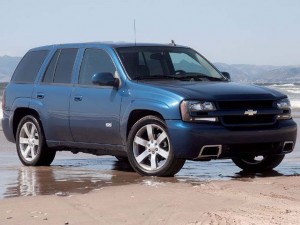Federal safety investigators have expanded an investigation launched last week when they initially responded to reports of six fires involving Toyota Camry and RAV-4 models. A similar problem, with fires apparently starting in the driver door of the Chevrolet TrailBlazer, is now being investigated, as well – and authorities want to know if the problems are linked.
The Toyota door fires were apparently linked to defective power window switches and could impact as many as 830,000 vehicles. But, as TheDetroitBureau.com reported last week, the Japanese maker improves its economies of scale by sharing such components in a wide range of products and it is possible still more Toyota vehicles could be roped in by the investigation.
It is also common practice for suppliers to offer similar – and sometimes identical – parts and components to more than one automaker. That could be the case with the 2006 to 2007 TrailBlazer, with 309,000 of the SUVs involved in the latest investigation.
So far, the National Highway Traffic Safety Administration says it has received reports of an even dozen incidents where owners reported smoke or fires in the driver doors of their TrailBlazers. There have been no reports of injuries, and while the vehicles were damaged none were destroyed, improving the odds of identifying the precise cause of the problem.
That could prove more challenging than it first might appear, as NHTSA has so far received no reports of fires involving three other General Motors SUVs that shared the power window switches with the 2006 – 2007 Chevrolet TrailBlazer: the GMC Envoy, Buick Rainier and Saab 9-7X.
Nonetheless, if the switch, rather than another problem such as faulty installation, is shown to be the cause of the fires, NHTSA could eventually order the recall of a wide range of products. Indeed, if the switch proves to be the problem linking the reports of GM and Toyota fires, all models using the switch could be targeted – even if still other manufacturers turn out to be involved.
It is becoming increasingly common for individual automakers to share parts among a wide range of products in order to reduce costs. And suppliers, in turn, try to maximize their own economies of scale by duplicating components for various brands with little or no changes. That’s usually considered an acceptable practice when it comes to components the customer doesn’t directly see.
But the approach can have costly consequences if a part proves defective, as Toyota discovered in early 2010 when it was forced to recall millions of vehicles – and briefly halt production on a half-dozen key products – when it discovered it was using a potentially sticky accelerator assembly.
GM was dragged into that recall, as well, because it shared the faulty part on the Pontiac Vibe model produced at a California assembly plant the U.S. maker ran under a joint venture with Toyota.
For the moment, at least, NHTSA is just investigating the door fire problem. It remains to be seen whether it will order a full recall.

